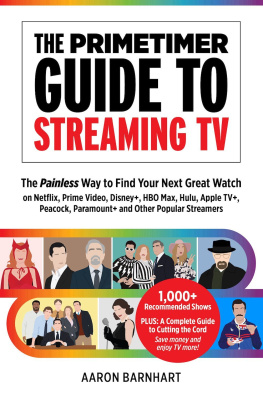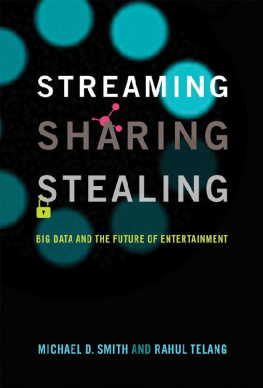From Networks to Netflix
Even as the television industry experiences significant transformation and disruption in the face of streaming and online delivery, the television channel itself persists. If anything, the television channel landscape has become more complex to navigate, as viewers can now choose between broadcast, cable, streaming, and premium services across a host of different platforms and devices. From Networks to Netflix provides an authoritative answer to that navigational need, helping students, instructors, and scholars understand these industrial changes through the lens of the channel. Through examination of emerging services like Hulu and Amazon Prime Video, investigation of YouTube channels and cable outlets like Freeform and Comedy Central, and critiques of broadcast giants like ABC and PBS, this book offers a concrete, tangible means of exploring the foundations of a changing industry.
Derek Johnson is Associate Professor of Media and Cultural Studies at the University of WisconsinMadison. He is the author of Media Franchising: Creative License and Collaboration in the Culture Industries , as well as the co-editor of A Companion to Media Authorship, Making Media Work: Cultures of Management in the Entertainment Industries , and the forthcoming Point of Sale: Analyzing Media Retail .
From Networks to Netflix
A Guide to Changing Channels
Edited by Derek Johnson
First published 2018
by Routledge
711 Third Avenue, New York, NY 10017
and by Routledge
2 Park Square, Milton Park, Abingdon, Oxon OX14 4RN
Routledge is an imprint of the Taylor & Francis Group, an informa business
2018 Taylor & Francis
The right of Derek Johnson to be identified as the author of the editorial material, and of the authors for their individual chapters, has been asserted in accordance with sections 77 and 78 of the Copyright, Designs and Patents Act 1988.
All rights reserved. No part of this book may be reprinted or reproduced or utilised in any form or by any electronic, mechanical, or other means, now known or hereafter invented, including photocopying and recording, or in any information storage or retrieval system, without permission in writing from the publishers.
Trademark notice : Product or corporate names may be trademarks or registered trademarks, and are used only for identification and explanation without intent to infringe.
Library of Congress Cataloging-in-Publication Data
Names: Johnson, Derek, 1979 editor.
Title: From networks to Netflix : a guide to changing channels / [edited by] Derek Johnson.
Description: New York : Routledge, 2018. | Includes bibliographical references.
Identifiers: LCCN 2017038503 | ISBN 9781138998490 (hardback) | ISBN 9781138998513 (pbk.) | ISBN 9781315658643 (ebk.)
Subjects: LCSH: Television viewersEffect of technological innovations on. | Television broadcastingTechnological innovationsUnited States. | Streaming technology (Telecommunications)
Classification: LCC HE8700.66.U6 F76 2018 | DDC 302.23/45dc23
LC record available at https://lccn.loc.gov/2017038503
ISBN: 978-1-138-99849-0 (hbk)
ISBN: 978-1-138-99851-3 (pbk)
ISBN: 978-1-315-65864-3 (ebk)
Typeset in Warnock Pro
by Apex CoVantage, LLC
Channel Listings
|
Derek Johnson |
|
Kristen J. Warner |
Caryn Murphy |
Courtney Brannon Donoghue |
Michele Hilmes |
Allison Perlman |
Hanne Bruun |
Derek Kompare |
|
Christine Becker |
Travis Vogan |
Deborah L. Jaramillo |
Jon Kraszewski |
Melissa Zimdars |
Laurie Ouellette |
David Craig and Derek Johnson |
Amanda D. Lotz |
Nick Marx |
Erin Copple Smith |
Kyra Hunting and Jonathan Gray |
Christopher Chvez |
Barbara Selznick |
Alisa Perren |
|
Avi Santo |
Lori Kido Lopez |
Subin Paul |
James Bennett and Niki Strange |
Matthew Thomas Payne |
Faye Woods |
Aymar Jean Christian |
|
Timothy Havens |
Evan Elkins |
Michael Curtin and Yongli Li |
Karen Petruska |
Peter Alilunas |
Myles McNutt |
Cory Barker and Andrew Zolides |
Derek Johnson |
Derek Johnson
In fall 2014, the US-based TV Guide Network announced it would abandon its name to become a new service called Pop. With ratings still on the rise for the existing channel, press releases described this shift not as a complete revolution so much as a brand refresh; carrying over interest in celebrity and celebration of television inherited from its predecessor, Pop would focus on entertainment and the world of fandom. Channel president Brad Schwartz promised this embrace of pop culture would support quality programming so good, it pops (Network 2014). Yet one could also read a third kind of pop from this development: the bursting of linear models of television delivery in which many viewers relied upon print and electronic versions of TV Guide (or some other ordered list of channels and their scheduled program offerings) to navigate a complex channel environment.
When first published in 1953, TV Guide magazine featured in-color entertainment news stories about television stars and national network programming as well as black-and-white listings of the channels and programs scheduled for viewers throughout the day, with localized versions produced for over 100 different areas of the US. While TV Guide was the single most circulated national magazine in the 1960s (Farber and Bailey 2001, 397), the navigational need shared by television viewers supported similar efforts by TV Choice (United Kingdom), Figaros TV Magazine (France), local newspapers, and many more publications across the world. Feature stories, spotlight reviews, and starred ratings all helped readers sort through their viewing choicesto which channels curated programming lineups should they tune their televisions? This problem of choice would only exacerbate as new cable and satellite services joined terrestrial broadcast channels, beginning in the 1970s and expanding through the 1990s. Viewers required a guide in a crowded channel landscape.
The cable service TV Guide Network brought this navigational function to the television screen, experimenting with a mix of scrolling program listings and entertainment features. TV Guide Network was a channel about channels, providing viewers with a portal to the hundreds of choices available to them. As one of those choices, however, TV Guide faced pressure to thrive as an entertainment service in its own right; to attract carriage fees and advertising revenues, the channel needed to be more than a waystation for television viewing, but also a destination in and of itself (Motavalli 2004). Between 1999 and 2013, this pressure led to experimentation with new programming formats to run alongsideand eventually replaceits listings. The disappearance of TV Guide Network in favor of Pop, therefore, represents not just abandoned brand legacy, but more significantly the passage of an entire navigational apparatus for engaging with linear television. One might assume that viewers simply do not need this kind of guide anymore. Able to subscribe to, search for, and stream programs rather than relying on the linear programming schedules of broadcast and cable channels, the users of newer non-linear services like Netflix and Hulu have no need for program listings. Non-linear viewers can be their own guides.












